
Cirkit Designer
Your all-in-one circuit design IDE
Home /
Component Documentation
How to Use Fermion: MEMS Ammonia NH3 Gas Detection Sensor (Breakout, 1-300ppm): Examples, Pinouts, and Specs
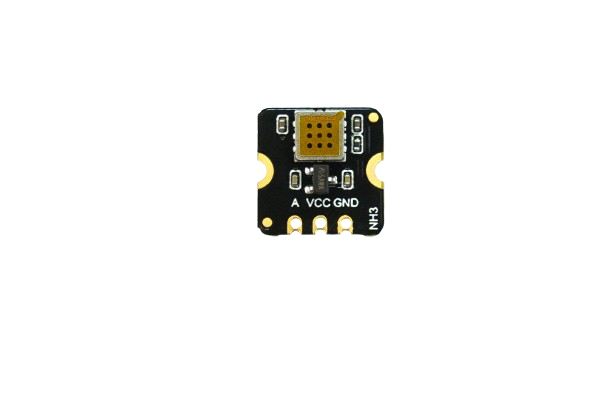
 Design with Fermion: MEMS Ammonia NH3 Gas Detection Sensor (Breakout, 1-300ppm) in Cirkit Designer
Design with Fermion: MEMS Ammonia NH3 Gas Detection Sensor (Breakout, 1-300ppm) in Cirkit DesignerIntroduction
The :Fermion: MEMS Ammonia NH3 Gas Detection Sensor is a high-precision module designed to detect ammonia gas concentrations in the range of 1-300ppm. Utilizing advanced MEMS (Micro-Electro-Mechanical Systems) technology, this sensor offers reliable and accurate measurements, making it ideal for various environmental monitoring applications. Common use cases include air quality monitoring, industrial safety, and agricultural applications.
Explore Projects Built with Fermion: MEMS Ammonia NH3 Gas Detection Sensor (Breakout, 1-300ppm)
Arduino UNO Based Gas Leak Detector with GSM Notification and Servo Valve Control
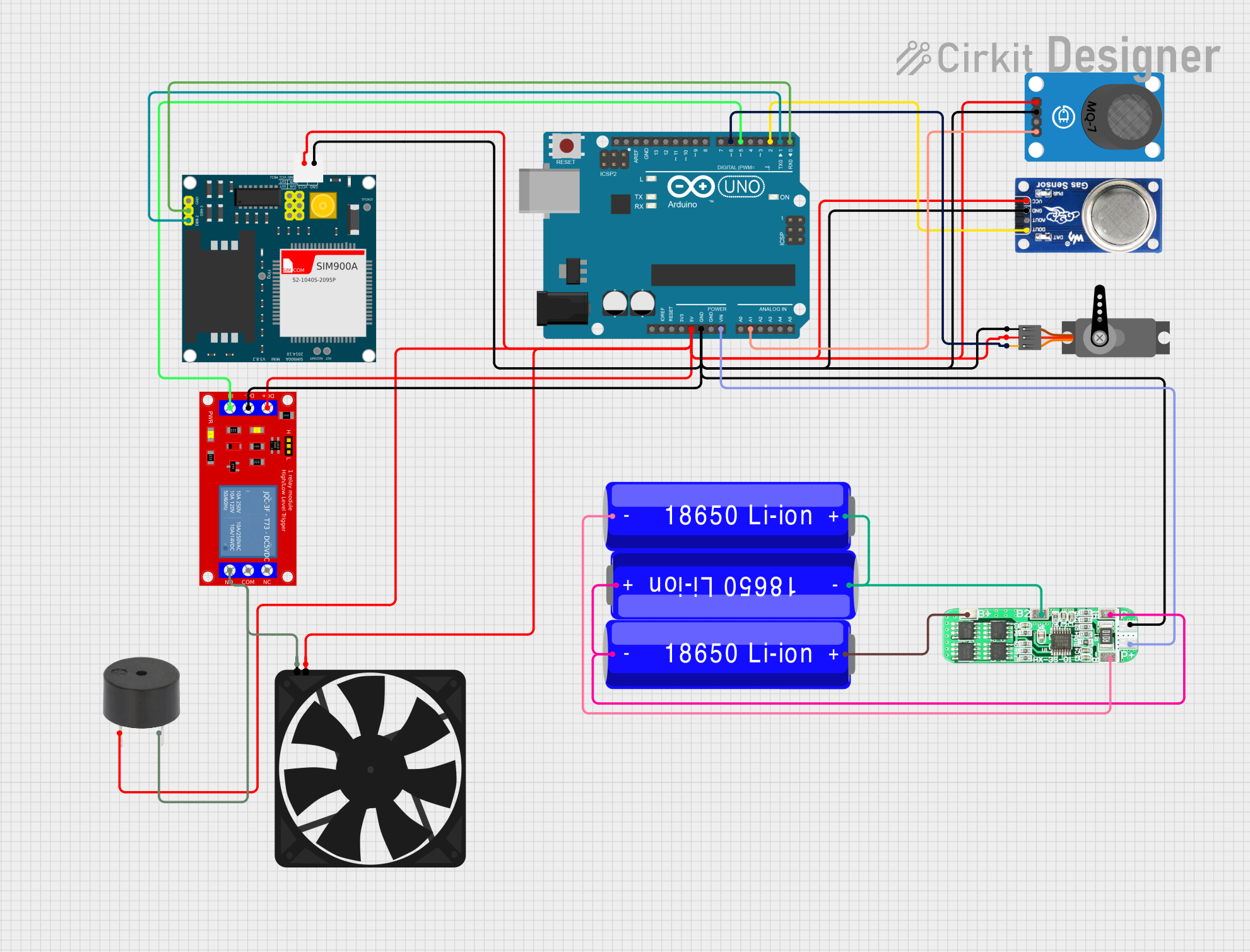
This circuit is designed as a gas leakage detection system with SMS alert capabilities. It uses an Arduino UNO to monitor MQ-6 and MQ-7 gas sensors for LPG and CO levels, respectively, and activates a servo-controlled valve, buzzer, and exhaust fan if gas concentrations exceed preset thresholds. Additionally, the system uses a SIM900A GSM module to send SMS alerts in case of gas detection, and it is powered by a series of 18650 Li-ion batteries managed by a protection board.
 Open Project in Cirkit Designer
Open Project in Cirkit DesignerESP32-Based Gas Detection System with Wi-Fi Notification
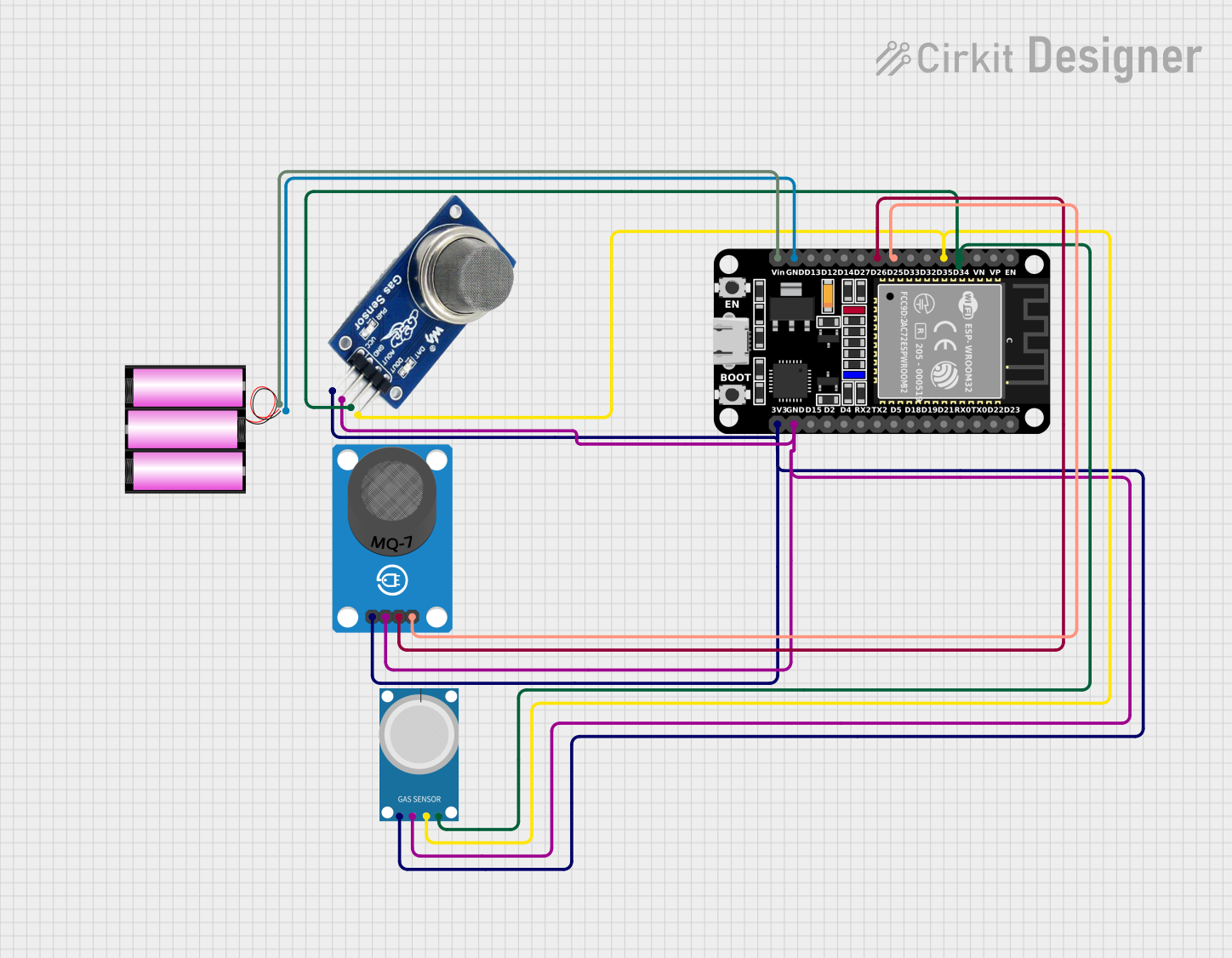
This circuit is a gas detection system using an ESP32 microcontroller connected to three gas sensors (MQ2, MQ-4, and MQ-7). The ESP32 reads both digital and analog signals from the sensors to monitor gas levels and sends notifications via Blynk if any gas concentration exceeds a predefined threshold.
 Open Project in Cirkit Designer
Open Project in Cirkit DesignerBattery-Powered Gas Sensor with Buzzer Alert using MQ-2 and LM7805
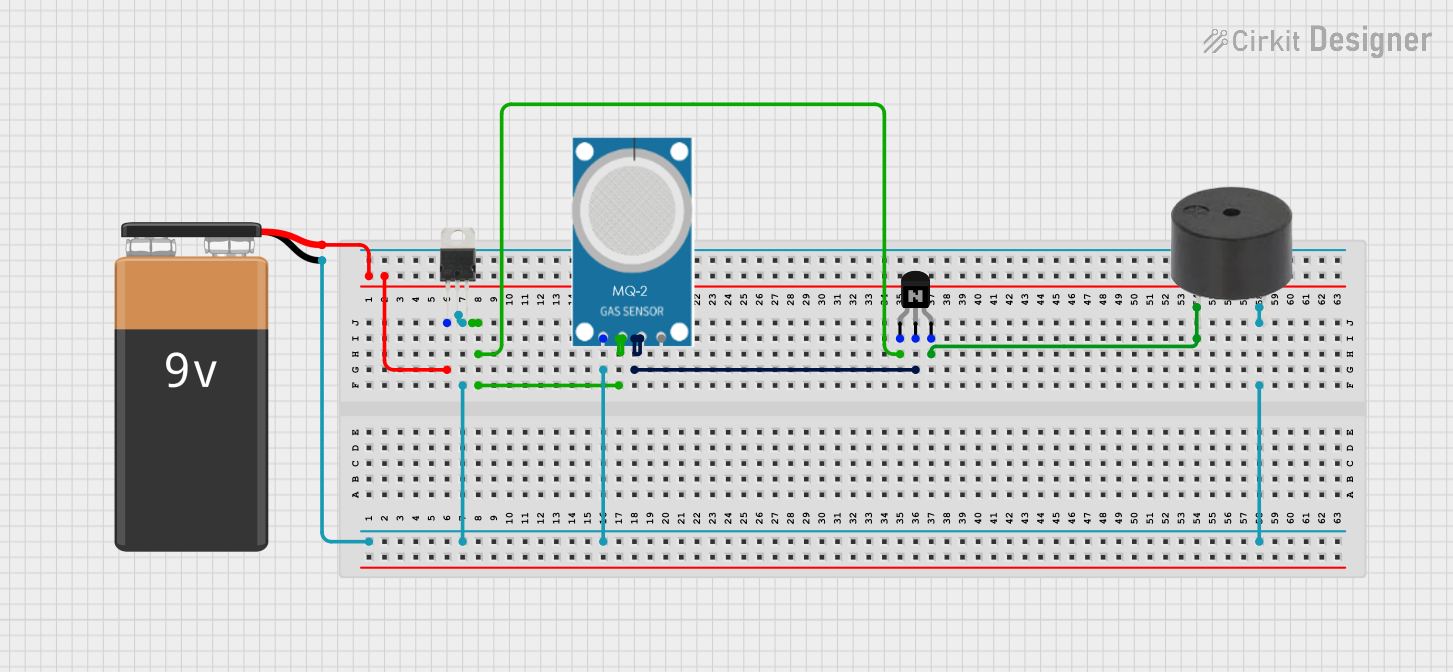
This circuit is a gas detection system powered by a 9V battery, which uses an MQ-2 gas sensor to detect gas levels. The sensor's analog output controls an NPN transistor, which in turn activates a buzzer to provide an audible alert when gas is detected. The LM7805 voltage regulator ensures a stable 5V supply to the sensor and other components.
 Open Project in Cirkit Designer
Open Project in Cirkit DesignerArduino-Based Gas Leakage Detector with MQ-2 Sensor and SIM900A GSM Module
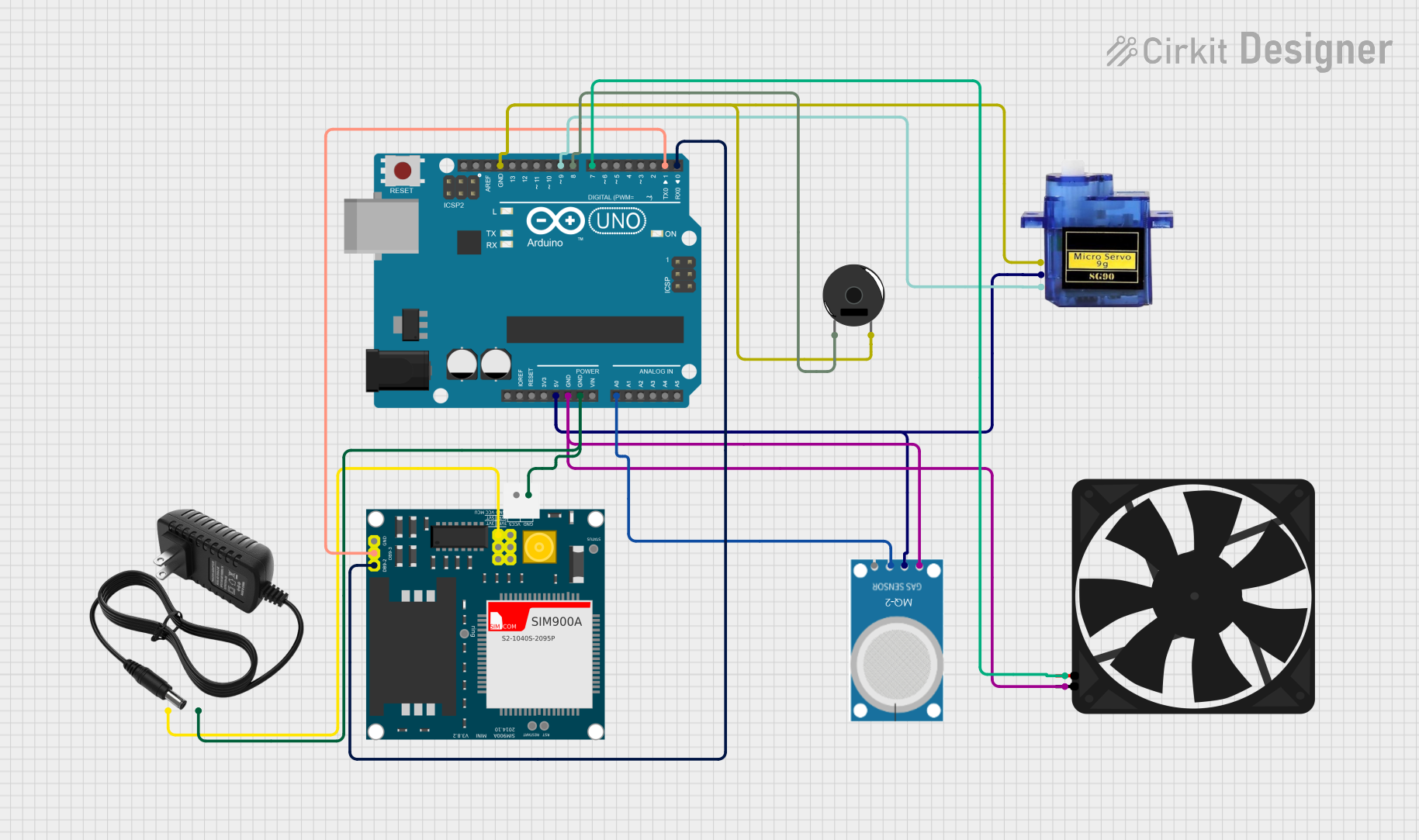
This circuit is a gas leakage detection system that uses an MQ-2 gas sensor to monitor gas levels. If the gas level exceeds a predefined threshold, the Arduino UNO triggers a buzzer, activates a cooling fan, opens a valve using a servo motor, and sends an SMS alert and makes a call via the SIM900A GSM module.
 Open Project in Cirkit Designer
Open Project in Cirkit DesignerExplore Projects Built with Fermion: MEMS Ammonia NH3 Gas Detection Sensor (Breakout, 1-300ppm)

Arduino UNO Based Gas Leak Detector with GSM Notification and Servo Valve Control
This circuit is designed as a gas leakage detection system with SMS alert capabilities. It uses an Arduino UNO to monitor MQ-6 and MQ-7 gas sensors for LPG and CO levels, respectively, and activates a servo-controlled valve, buzzer, and exhaust fan if gas concentrations exceed preset thresholds. Additionally, the system uses a SIM900A GSM module to send SMS alerts in case of gas detection, and it is powered by a series of 18650 Li-ion batteries managed by a protection board.
 Open Project in Cirkit Designer
Open Project in Cirkit Designer
ESP32-Based Gas Detection System with Wi-Fi Notification
This circuit is a gas detection system using an ESP32 microcontroller connected to three gas sensors (MQ2, MQ-4, and MQ-7). The ESP32 reads both digital and analog signals from the sensors to monitor gas levels and sends notifications via Blynk if any gas concentration exceeds a predefined threshold.
 Open Project in Cirkit Designer
Open Project in Cirkit Designer
Battery-Powered Gas Sensor with Buzzer Alert using MQ-2 and LM7805
This circuit is a gas detection system powered by a 9V battery, which uses an MQ-2 gas sensor to detect gas levels. The sensor's analog output controls an NPN transistor, which in turn activates a buzzer to provide an audible alert when gas is detected. The LM7805 voltage regulator ensures a stable 5V supply to the sensor and other components.
 Open Project in Cirkit Designer
Open Project in Cirkit Designer
Arduino-Based Gas Leakage Detector with MQ-2 Sensor and SIM900A GSM Module
This circuit is a gas leakage detection system that uses an MQ-2 gas sensor to monitor gas levels. If the gas level exceeds a predefined threshold, the Arduino UNO triggers a buzzer, activates a cooling fan, opens a valve using a servo motor, and sends an SMS alert and makes a call via the SIM900A GSM module.
 Open Project in Cirkit Designer
Open Project in Cirkit DesignerTechnical Specifications
Key Technical Details
| Parameter | Value |
|---|---|
| Detection Range | 1-300 ppm |
| Operating Voltage | 3.3V - 5V |
| Operating Current | < 10mA |
| Response Time | < 30 seconds |
| Recovery Time | < 60 seconds |
| Operating Temperature | -20°C to 50°C |
| Humidity Range | 15% - 90% RH (non-condensing) |
Pin Configuration and Descriptions
| Pin | Name | Description |
|---|---|---|
| 1 | VCC | Power supply (3.3V - 5V) |
| 2 | GND | Ground |
| 3 | AOUT | Analog output signal |
| 4 | DOUT | Digital output signal (threshold) |
Usage Instructions
How to Use the Component in a Circuit
- Power Supply: Connect the VCC pin to a 3.3V or 5V power supply and the GND pin to the ground.
- Analog Output: Connect the AOUT pin to an analog input pin on your microcontroller to read the ammonia concentration.
- Digital Output: Connect the DOUT pin to a digital input pin on your microcontroller to detect if the ammonia concentration exceeds a predefined threshold.
Important Considerations and Best Practices
- Calibration: Allow the sensor to warm up for at least 24 hours before taking accurate measurements.
- Placement: Place the sensor in an area with good airflow to ensure accurate readings.
- Power Supply: Ensure a stable power supply to avoid fluctuations in sensor readings.
- Humidity and Temperature: Operate the sensor within the specified humidity and temperature ranges to maintain accuracy.
Example Code for Arduino UNO
// Include necessary libraries
const int analogPin = A0; // Analog input pin connected to AOUT
const int digitalPin = 2; // Digital input pin connected to DOUT
void setup() {
Serial.begin(9600); // Initialize serial communication at 9600 baud
pinMode(digitalPin, INPUT); // Set digital pin as input
}
void loop() {
int analogValue = analogRead(analogPin); // Read the analog value
int digitalValue = digitalRead(digitalPin); // Read the digital value
// Convert the analog value to a voltage
float voltage = analogValue * (5.0 / 1023.0);
// Print the analog value and voltage to the serial monitor
Serial.print("Analog Value: ");
Serial.print(analogValue);
Serial.print(" - Voltage: ");
Serial.print(voltage);
Serial.println("V");
// Check if the digital output is high
if (digitalValue == HIGH) {
Serial.println("Ammonia concentration exceeds threshold!");
} else {
Serial.println("Ammonia concentration is below threshold.");
}
delay(1000); // Wait for 1 second before the next reading
}
Troubleshooting and FAQs
Common Issues Users Might Face
- Inaccurate Readings: Ensure the sensor has been calibrated and has had sufficient warm-up time.
- No Output Signal: Check the power supply connections and ensure the sensor is receiving the correct voltage.
- Fluctuating Readings: Verify that the power supply is stable and that the sensor is placed in an area with consistent airflow.
Solutions and Tips for Troubleshooting
- Calibration: Allow the sensor to warm up for at least 24 hours before taking accurate measurements.
- Stable Power Supply: Use a regulated power supply to avoid fluctuations in sensor readings.
- Environmental Factors: Ensure the sensor is operated within the specified temperature and humidity ranges.
By following this documentation, users can effectively integrate the :Fermion: MEMS Ammonia NH3 Gas Detection Sensor into their projects, ensuring accurate and reliable ammonia gas detection.